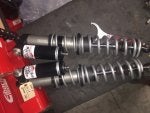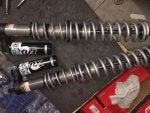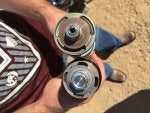First, thanks very much for taking time to share your expertise. I am trying to make sense of the analogies used and what that means settings wise. Let me start by saying that I don't doubt anything you are saying as I am sure it is 100% correct. However, shock settings and crossovers are completely new to me so some of my questions will likely be quite ignorant...I'm just trying to learn. So, to ensure I am understanding your descriptions and recommendations, I would like to ask some questions and should you be so kind as to answer, it is extremely appreciated. I know the ride on my SS SE is can be vastly improved so I am hoping to gain some insight so I can improve the ride.
Open = CCW which means allowing oil to flow more freely. Result being softer ride and faster response from shock in/out?
Closed = CW which means restricting oil flow, i.e. stiffening the ride and slower response on shock in/out?
I am assuming by X2, we are talking about the SS SE shocks with the Internal bypass and everything that follows is guidance based upon that assumption.
To add, for the stock X2
The stock valving is over hard right away.
Picture having just a regular firm mattress for a bed you sleep in. Nearly no padding. It’s good firm, but gets irritating because there is no plushness on top. Right? And that firm mattress is probably not that thick either. So when you jump into bed or bounce big, it bottoms out because it has no suport behind it.
The above is similar to the stock Fox valving.
So lets go get a new bed that works better and meets more of our needs. I personally like a bed that has a good plush pillow top with padding that introduces the user to a good firm thick mattress.
This is the type of valve job that goes into all our shocks. Softer beginnings mean less deflection off the terain and more control of the car.
Some tuners are valving the mattress to be softer to get the plusher ride. But that just makes it more difficult to control bottom out, and then the ride gets firm again as all the adjusters must be set to the firmest settings to compensate. Or valve to a firmer mattress to control bottom out, and suffer the harsh ride over the rough.
For both yxz Fox Compression hi/low adjusters, think of it this way. The 17mm high speed adjuster is for your “pillow top pad”
The low speed flat head screwdriver adjuster is for the “mattress”. For bottom out, you adjust the mattress, for a plusher Or rougher ride, adjust the mattress pad. Make sense anyone??
So, run that 17mm full open to start on all 4 shocks! We want the softest pad we can get with the stock valving. ONLY make adjustments using the flathead screwdriver mattress adjuster. If you end up with this adjuster full closed, then you can start using the 17mm mattress pad adjuster.
I'm not sure I understand why the high speed settings are the pillow top pad and the low speed settings are the bottom out control. I had thought the high speed settings dictated how fast the shock would compress and rebound when driving fast over hard hitting terrain. So, I am not quite getting how a pillow top relates to high speed driving over rough terrain. Equally, I don't understand how the low speed settings equal the firm mattress. Am I thinking of this wrong?
I'm also confused by this sentence..."So, run that 17mm full open to start on all 4 shocks! We want the softest pad we can get with the stock valving. ONLY make adjustments using the flathead screwdriver mattress adjuster. If you end up with this adjuster full closed, then you can start using the 17mm mattress pad adjuster."
Does this mean CCW all the way on the 17mm (High speed) and once that is done, then start making small adjustments to the low speed. Only after you have dialed the low all the way in and cannot get the desired ride, go back to the 17mm and start adjusting?
To add, for the stock X2
Next
The front end needs more ride hight ! And the rebound settings are to slow.
The rear is over firm to soon, and rebound is to fast.
For any one that has dirt bike or quad experience, this will make sense. Think about running through a rough or whooped out stretch. Where is your body? And throttle? Throttle is usually increased and your butt is back over the rear of seat or fender to keep some leverage on the rear end. You pull back on the bars a bit and use throttle to keep the FRONT END up and Bike level over the terrain, or else what happens??? You end up over the bars as the FRONT END DIVES and the rear high.
Same effects happen to the yxz. But we cant hang our ass over the rear fender now can we?? So we have to make adjustments to help keep the car level.
Front end needs to sit a little taller, move those crossovers lower on the shock to engage the bottom spring sooner to push the front end up sooner and faster after compression. Run faster rebound settings. Don’t forget the adjuster setting explained above. Start soft compression. But the low speed will need to be turned firm a few turns.
Rear can be started full compression soft to start. Part of the rear hop is because of over firm compression settings. (Compression hop).
Rear Rebound here will be run at much slower settings than stock to slow down the rebound after compressions. This will help keep the rear tires loaded and on the ground.
Use the rear crossover rings to help with bottom out resistance. The lower the crossover, the sooner it will engage bottom spring, and spring rate will increase much faster. This also adds to body roll control as the car is leaning on a firmer spring sooner As the crossovers come downward. rebound needs to be continually increased (slow down). Since the higher spring rates used will have more power to push and extend the shocks outward and rear end to the sky. These adjustments should be done with the compression adjusters pretty much full open. Only after these crossover and rebound settings are in a good spot can the compression setting start to get adjustments. This will get the softest ride posssible out of the stock valving.
Moto!
The analogy of the bike over whoops makes perfect sense. So when you say move the crossover ring lower to engage heavy spring sooner, this means compress the heavy spring more (ie. more preload)? So, how far do you move it down? If you move it down, doesn't that opens up the tender spring more (less preload on the tender spring)?
If you change the crossover ring, you say you need to adjust the rebound. Does that mean that the steps you just did before are no longer valid? Should you do the crossover ring first so you don't have to go back and start tweaking the rebound settings again?
Yo said Rear can be started full compression soft to start. Is that the 17mm or the screwdriver? If the 17mm, didn't we do that in step 1 already?
Thanks again. I'm trying to wrap my head around the physics of each of these settings and perhaps that is the wrong way to look at it.








